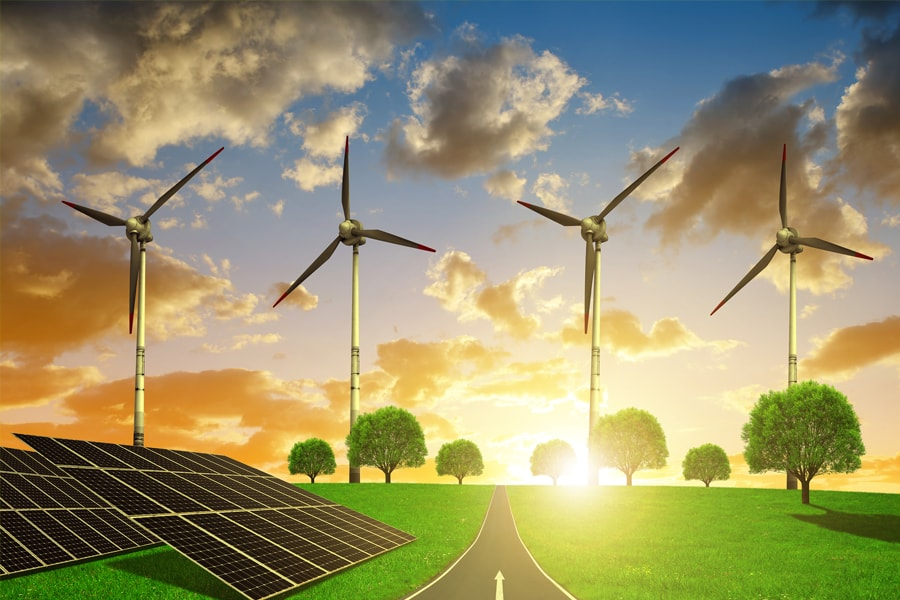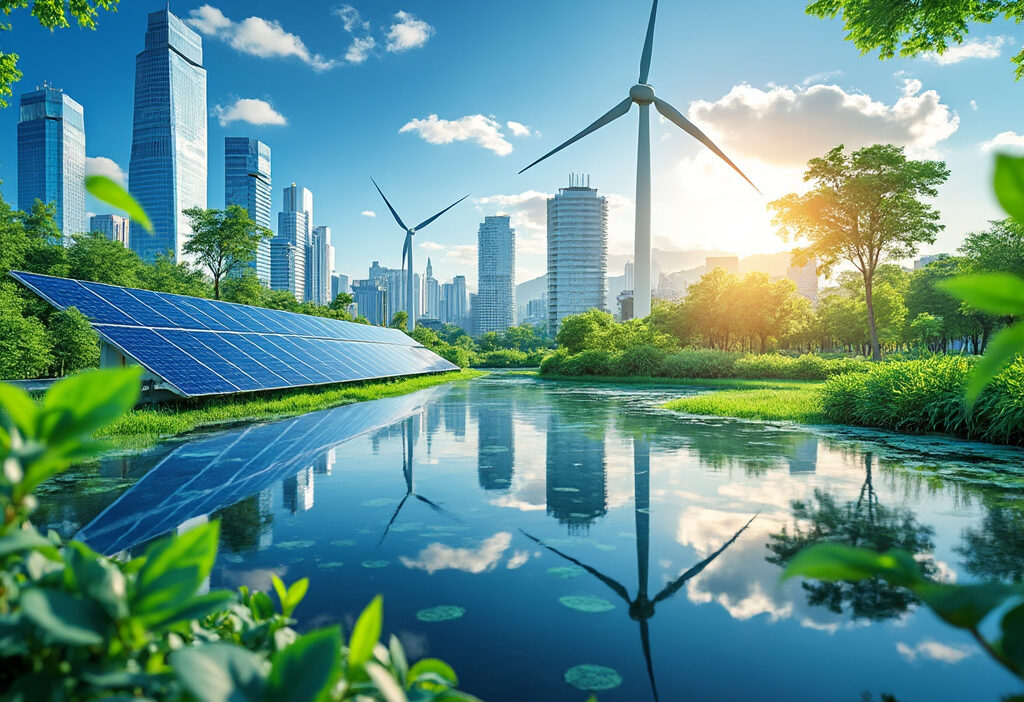Powering the Future: How Green Energy Startups Are Leading the Clean Tech Revolution
In 2025, the world is witnessing an unprecedented shift towards renewable energy, spearheaded by innovative green energy startups. Amid growing environmental concerns and technological advancements, these startups are redefining the energy sector, making clean tech not just a possibility, but a reality. This article explores the key trends, challenges, and breakthroughs driving this transformation, offering insights into a future powered by green energy.
The Dawn of a New Energy Era
The year 2025 marks a turning point in the global energy paradigm, where green energy startups have emerged as the vanguard of the clean tech revolution. No longer confined to niche markets, these innovators are redefining how energy is generated, stored, and distributed. Unlike traditional energy giants burdened by legacy infrastructure, startups are leveraging agile methodologies and cutting-edge technologies to deliver scalable solutions at unprecedented speeds. From advanced perovskite solar cells to AI-driven grid optimization, these companies are pushing the boundaries of what’s possible.
Three key drivers are fueling this transformation: cost parity, consumer demand, and corporate partnerships. Solar and wind energy have now achieved cost competitiveness with fossil fuels, thanks to breakthroughs in material science and manufacturing efficiency. Consumers, increasingly aware of climate urgency, are demanding cleaner energy options, forcing utilities and corporations to adapt. Meanwhile, strategic alliances between startups and industrial players are accelerating deployment—think Tesla’s Powerpack deployments or NextEra’s wind farm collaborations.
- Energy storage has become a linchpin, with startups like Form Energy and QuantumScape revolutionizing long-duration batteries, enabling renewables to overcome intermittency.
- Decentralization is another trend, as microgrid startups empower communities to generate and trade energy peer-to-peer, reducing reliance on centralized systems.
- Digital integration is critical, with IoT and blockchain enabling real-time energy tracking and transparent carbon credit markets.
This isn’t just about replacing coal with solar—it’s a systemic overhaul. Startups are embedding sustainability into the DNA of energy systems, proving that green tech isn’t the future—it’s the present. As policies and investments align (as explored in the next chapter), their role will only expand, cementing their position as the architects of a new energy era.
Government’s Role and Policy Impact
The acceleration of renewable energy adoption in 2025 owes much to the strategic role of government policies, which have created a fertile ground for green energy startups to thrive. Subsidies and tax incentives have been pivotal in lowering the financial barriers for emerging clean tech companies, enabling them to compete with entrenched fossil fuel industries. For instance, the Renewable Energy Growth Initiative in the U.S. and the European Green Deal have provided startups with access to low-interest loans and grants, reducing the risks associated with early-stage innovation. These measures have not only spurred R&D but also accelerated the commercialization of cutting-edge technologies like perovskite solar cells and modular wind turbines.
Regulatory frameworks have also played a critical role in shaping the clean tech landscape. Governments worldwide have implemented mandates such as renewable portfolio standards (RPS) and carbon pricing, forcing utilities to integrate green energy into their grids. In markets like Germany and California, feed-in tariffs have guaranteed long-term revenue streams for startups, encouraging private investment. Additionally, streamlined permitting processes for renewable projects have cut bureaucratic red tape, allowing startups to deploy solutions faster than ever before.
Beyond financial and regulatory support, public-private partnerships have emerged as a key driver of innovation. Initiatives like the Clean Energy Incubator Program have connected startups with national labs and universities, fostering collaboration on breakthrough technologies. As a result, the clean tech sector has seen unprecedented growth, setting the stage for the next wave of advancements in energy generation and distribution—a topic explored in the following chapter.
Breaking Ground in Energy Generation and Distribution
In 2025, green energy startups are redefining energy generation and distribution with disruptive technologies that challenge traditional infrastructure. Solar energy has moved beyond conventional photovoltaic panels, with startups like HelioNano pioneering ultra-thin, perovskite-based solar films that achieve 30% efficiency at half the cost of silicon panels. These films can be integrated into building facades, windows, and even vehicles, turning urban landscapes into decentralized power hubs. Meanwhile, wind energy is being revolutionized by AeroVortex, which deploys modular, vertical-axis turbines optimized for low-wind urban environments, drastically expanding renewable energy’s geographic reach.
Bioenergy is also undergoing a transformation, with startups like EcoSynth converting agricultural waste into high-energy-density biofuels using genetically engineered microbes. Their closed-loop systems minimize emissions while maximizing yield, offering a scalable alternative to fossil fuels for heavy industries.
On the distribution front, smart grids are becoming the backbone of the energy transition. Startups such as GridMind leverage AI to dynamically balance supply and demand, integrating renewables at unprecedented scales. Their self-healing grids detect and isolate faults in milliseconds, reducing downtime and improving resilience. Peer-to-peer energy trading platforms, like WattShare, empower communities to buy and sell excess renewable energy via blockchain, democratizing access and reducing reliance on centralized utilities.
These innovations are not just incremental improvements—they represent a fundamental shift in how energy systems operate. By decentralizing generation, optimizing distribution, and leveraging cutting-edge materials, green energy startups are laying the groundwork for a future where clean, reliable power is accessible to all. The next chapter will explore how breakthroughs in storage are ensuring this energy is available whenever and wherever it’s needed.
The Evolution of Energy Storage
The Evolution of Energy Storage
As renewable energy generation surges, the spotlight turns to energy storage—the linchpin for ensuring reliability and accessibility. While the previous chapter explored breakthroughs in solar, wind, and smart grids, this section delves into the innovations making intermittent renewables viable around the clock. Startups are redefining storage with cutting-edge battery technologies, thermal storage, and even gravity-based solutions, addressing the critical challenge of energy availability.
At the forefront are companies developing next-gen batteries, such as solid-state and flow batteries, which promise higher energy density, faster charging, and longer lifespans than traditional lithium-ion. Startups like QuantumScape and Form Energy are pushing boundaries, with the latter’s iron-air batteries offering multi-day storage at a fraction of current costs. Meanwhile, thermal storage innovators like Malta Inc. are converting excess electricity into heat, stored in molten salt, and later reconverted to power—ideal for industrial applications.
Beyond batteries, novel approaches are gaining traction. Gravity storage, exemplified by Energy Vault, uses excess energy to lift massive blocks, releasing kinetic energy when needed. Hydrogen storage is also making waves, with startups like H2Pro developing efficient electrolysis methods to store renewable energy as green hydrogen.
These advancements are not just technical feats—they’re reshaping energy economics. By slashing storage costs and improving efficiency, startups are enabling microgrids, off-grid solutions, and seamless integration of renewables into existing infrastructure. As AI-driven energy management (covered next) optimizes these systems, storage innovations ensure that clean energy is not just generated but always available, powering a resilient and decentralized future.
AI and Big Data: Revolutionizing Energy Management
The integration of artificial intelligence (AI) and big data into energy management is transforming how renewable energy systems operate, making them more efficient, predictive, and responsive. As the previous chapter highlighted breakthroughs in energy storage, this chapter explores how startups are using AI to optimize these systems, ensuring energy is not just stored but intelligently distributed and consumed.
AI-driven algorithms analyze vast datasets—from weather patterns to grid performance—enabling real-time adjustments in energy distribution. For instance, startups like DeepGrid and VoltAI are pioneering predictive energy demand models, which anticipate fluctuations in consumption and adjust supply accordingly. This minimizes waste and maximizes the use of stored renewable energy, bridging gaps when solar or wind generation dips.
Smart metering technologies, powered by AI, are another game-changer. These systems go beyond traditional meters by learning user behavior and automating energy-saving adjustments. Companies such as EcoSense deploy machine learning to identify inefficiencies in industrial and residential settings, reducing energy costs by up to 30%.
Big data also plays a crucial role in grid optimization. By processing real-time data from IoT-enabled devices, startups can detect faults before they cause outages and reroute power dynamically. This is particularly vital as the next chapter discusses the surge in electric vehicles (EVs), which will strain grids with increased demand. AI helps balance this load by predicting charging patterns and integrating EV batteries as decentralized storage units.
The synergy between AI, big data, and renewable energy is creating a smarter, more resilient energy ecosystem—one where every watt is accounted for and optimally utilized. As startups continue to innovate, the clean tech revolution is becoming not just sustainable but intelligently adaptive.
The Surge of Electric Vehicles and Infrastructure Development
The transition to electric vehicles (EVs) has accelerated dramatically in 2025, reshaping energy demand and infrastructure development. With global EV sales surpassing 25% of all new vehicle purchases, the strain on power grids and the need for robust charging networks has never been more pressing. Startups are at the forefront of this transformation, innovating solutions to ensure seamless integration of EVs into the energy ecosystem.
One key area of focus is smart charging infrastructure. Companies like VoltIQ and ChargeGrid are deploying AI-powered charging stations that optimize energy use based on grid load and renewable availability—complementing the AI-driven energy management systems discussed earlier. These startups are not just installing chargers; they’re building dynamic networks that communicate with utilities to balance demand, reducing peak load pressures.
Another breakthrough is battery-swapping technology, pioneered by firms such as SwapGo. This approach eliminates long charging waits by allowing drivers to replace depleted batteries with fully charged ones in minutes, a game-changer for fleets and urban mobility. Meanwhile, startups like EcoWatt are integrating solar-powered charging hubs, further aligning EV infrastructure with renewable energy sources.
The ripple effects extend beyond transportation. As EV adoption grows, energy storage solutions are evolving. Startups are repurposing retired EV batteries for grid storage, creating a circular economy that maximizes resource efficiency. This synergy between EVs and energy storage sets the stage for the next chapter’s exploration of hydrogen and alternative fuels, where multi-faceted energy solutions will further diversify the clean tech landscape.
The EV surge isn’t just about cars—it’s a catalyst for reimagining how we produce, distribute, and consume energy in a decarbonized world.
Harnessing the Potential of Hydrogen and Alternative Fuels
As the electric vehicle revolution reshapes transportation, another quiet but transformative shift is taking place in the energy sector: the rise of hydrogen and alternative fuels. While EVs dominate headlines, green hydrogen and synthetic fuels are emerging as critical solutions for hard-to-decarbonize industries like shipping, aviation, and heavy manufacturing. Startups are at the forefront of this movement, developing innovative methods to produce, store, and deploy these fuels at scale.
Hydrogen’s promise lies in its versatility. Unlike batteries, it can be stored for long periods and transported efficiently, making it ideal for sectors where electrification isn’t feasible. Companies like H2Pro and Electric Hydrogen are pioneering electrolysis technologies that split water into hydrogen and oxygen using renewable energy, drastically reducing costs. Meanwhile, startups such as Lavo are tackling storage challenges with metal hydride and liquid organic hydrogen carrier (LOHC) systems, enabling safer and more compact hydrogen solutions.
Beyond hydrogen, alternative fuels like ammonia and e-fuels are gaining traction. Synhelion, for instance, uses concentrated solar power to produce synthetic kerosene for aviation, while Monolith converts methane into clean hydrogen and carbon black. These innovations are critical for industries where direct electrification remains impractical.
However, challenges persist. Scaling production requires massive renewable energy inputs, and infrastructure for distribution is still nascent. Policy support and cross-industry collaboration will be essential to overcome these hurdles. As the market matures, startups that can navigate these complexities—while aligning with broader energy trends—will play a pivotal role in shaping a truly decarbonized future. The next chapter will explore how these companies are strategizing to thrive in an increasingly competitive and geopolitically charged landscape.
Navigating Market Dynamics and Competitive Landscapes
The renewable energy market in 2025 is a dynamic and fiercely competitive space, shaped by rapid technological advancements, shifting policy landscapes, and geopolitical tensions. Startups are navigating this complexity by leveraging agility and innovation to carve out niches in an industry traditionally dominated by established players. Supply chain disruptions and material shortages, particularly for critical minerals like lithium and rare earth elements, have forced startups to adopt resilient sourcing strategies, including localized supply chains and circular economy models. Meanwhile, fluctuating demand—driven by both policy incentives and consumer adoption—creates both opportunities and risks for emerging companies.
Geopolitical factors, such as trade restrictions and energy security concerns, are reshaping market access. Startups are responding by forming strategic alliances with governments and multinational corporations to secure funding and market penetration. For example, some are partnering with industrial giants to scale production, while others are focusing on modular and decentralized energy solutions to bypass infrastructure bottlenecks. Competition is intensifying, not just among startups but also from legacy energy firms pivoting toward renewables. To differentiate themselves, green energy innovators are doubling down on AI-driven optimization, predictive maintenance, and blockchain-enabled energy trading platforms.
Another critical strategy involves demand-side flexibility, where startups develop adaptive solutions like smart grids and dynamic pricing models to align supply with real-time consumption patterns. By anticipating regulatory shifts and consumer trends, these companies are positioning themselves as key players in the transition to a decarbonized economy—setting the stage for their global impact, as explored in the next chapter.
The Global Impact of Green Energy Startups
The global impact of green energy startups in 2025 is undeniable, as these innovators drive progress toward sustainable development goals while tackling climate change head-on. Unlike traditional energy players, these agile companies leverage cutting-edge technology and localized solutions to address energy poverty, reduce carbon footprints, and enhance energy security worldwide. Their influence extends beyond borders, reshaping energy access in both developed and emerging economies.
One standout example is SolShare, a Bangladesh-based startup that pioneered peer-to-peer solar energy trading in off-grid communities. By enabling households to buy and sell excess solar power via microgrids, SolShare has electrified over 50,000 homes while reducing reliance on fossil fuels. Similarly, Hydrostor, a Canadian firm, has revolutionized energy storage with compressed air systems, providing grid stability in regions with intermittent renewable supply. These startups exemplify how localized innovation can have a global ripple effect.
In Africa, startups like M-KOPA and Zola Electric are bridging the energy gap through pay-as-you-go solar systems, empowering millions without access to traditional grids. Meanwhile, European startups such as Northvolt are scaling sustainable battery production, reducing the carbon intensity of energy storage—a critical enabler for renewable adoption.
The collective efforts of these startups are accelerating the transition to net-zero emissions. By aligning with UN Sustainable Development Goals (SDGs), particularly SDG 7 (Affordable and Clean Energy) and SDG 13 (Climate Action), they prove that scalable, decentralized solutions can outpace legacy systems. Their success underscores a broader shift: the clean tech revolution isn’t just about technology—it’s about redefining energy equity on a planetary scale. As the following chapter will explore, their innovations set the stage for an even more transformative future.
Looking Ahead: The Future of Clean Energy
As we look toward the future of clean energy in 2025 and beyond, green energy startups are poised to play an even more transformative role in the global energy transition. The rapid pace of technological innovation, coupled with shifting regulatory landscapes and evolving consumer demands, is creating a fertile ground for startups to redefine how energy is generated, stored, and distributed.
One of the most promising advancements is the integration of artificial intelligence and machine learning into energy systems. Startups are leveraging these technologies to optimize grid performance, predict energy demand with unprecedented accuracy, and enhance the efficiency of renewable sources like solar and wind. For example, AI-driven microgrids are enabling communities to achieve energy independence while minimizing waste.
Another key trend is the rise of next-generation energy storage solutions. Breakthroughs in solid-state batteries, hydrogen storage, and thermal energy systems are addressing one of the biggest challenges in renewable energy—intermittency. Startups pioneering these technologies are not only making clean energy more reliable but also more accessible to underserved regions.
Regulatory changes will also shape the future. Governments worldwide are increasingly backing clean energy initiatives with incentives and stricter emissions standards, creating opportunities for startups to scale their solutions. Meanwhile, corporate demand for sustainable energy is surging, with companies seeking to meet net-zero targets through partnerships with innovative green tech firms.
The road ahead is not without challenges, including funding gaps and infrastructure hurdles. However, the agility and creativity of green energy startups position them as critical drivers of the clean tech revolution. As they continue to push boundaries, their impact will extend far beyond energy—reshaping economies, empowering communities, and safeguarding the planet for generations to come.

Conclusions
As 2025 unfolds, green energy startups are undeniably at the heart of the clean tech revolution, driving significant advancements in renewable energy technologies and solutions. By overcoming challenges and leveraging innovations, these startups are not only addressing immediate energy needs but are also shaping a sustainable future. The clean energy revolution, led by these trailblazers, signifies a pivotal shift toward an era of environmental stewardship and technological progress.



